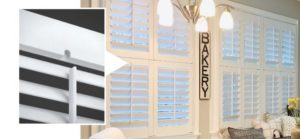Plantation Shutters have many names. Interior Shutters, Plantation Blinds, and Louvered Shutters are just a few. They also have many parts, which can make the shutter customization process a bit confusing and sometimes overwhelming.
But don’t worry – our plantation shutter experts are here to help! We’ve put together a glossary detailing the most common, and even some uncommon, plantation shutter parts:
Beaded Stile
The louvers of your plantation shutters have nylon pins that connect the louvers to the sidepieces of your shutter panel. These sidepieces are known as beaded stiles At 2″ wide x 1″ in thickness, beaded stiles allow for your louvers to rotate into the open and closed positions.
Bottom Rail
The bottom rail is the horizontal piece connected to the beaded stiles at the lowest point of your shutter panel. The rail connects to the stiles using 3 hardwood dowels, providing a strong and durable joint. Usually the same size as the top rail, the bottom rail will measure between 3” and 5” in height.
Divider Rail
The divider rail is an optional feature that provides the panel with greater structural integrity while also improving function by allowing the top and bottom sections of your shutter louvers to be opened and closed independently. The divider rail can be 4″ tall for panels with 2.5″ or 4.5″ louvers, or 3″ tall for 3.5″ louvers.
Hardwood Dowels
Measuring 3″ x 3/8″ in diameter, hardwood dowels are used to connect the rails of your shutter panel to the beaded stiles. Three dowels are used in each joint, ensuring that your shutter panel is strong, durable, and secure.
Hidden Tilt Strip
A hidden tilt strip is a feature unique to Superview Shutters. Traditional plantation shutters have a tilt rod located on the front center of the shutter panel that connects all of the louvers. A hidden tilt trip, however, is located on the backside of the panel and replaces the traditional tilt rod. Removing the tilt rod and using a hidden tilt strip creates a sleek, contemporary look boasting unobstructed views.
Louvers
Louvers are the angled slats attached to the stiles of the plantation shutter panel. Available in 2.5”, 3.5”, and 4.5” slat sizes, louvers can be customized even further with either tapered or flat profiles.
Louver Pins
Louver pins connect the shutter louvers to the beaded stiles. The pins are made of nylon, ensuring that the louvers have a smooth and seamless rotation.
Mousehole
The mousehole is a routed hole located in the top rail of your shutter panel. This hole acts as a space for the tilt bar to go when the louvers are in the upright, fully closed position. The mousehole also allows your plantation shutter to close more tightly, providing the highest level of privacy and energy-efficiency.
T-Post
T-posts connect to the frame of your plantation shutter for additional support. Because Acadia plantation shutters are made of premium basswood, T-Posts help to evenly distribute the weight of the shutter panels. This is especially important for larger windows.
Tension Screws
Tension screws are located on either side of the shutter panel, allowing you to adjust the tension of your louvers with a basic Phillips head screwdriver.
Tilt Rod
Measuring 3/8″ by 1/2″, the tilt rod is attached to the louvers and can be raised or lowered to open and close the louvers as needed. You may also choose to have a split tilt rod, which allows for the upper and lower louvers to move independently of each other.
Top Rail
The top rail of your shutter panel connects the upper left and right stiles. The rail connects to the stiles using 3 hardwood dowels, providing an extremely durable joint. Typically the same size as the bottom rail measuring between 3” and 5” in height, the top rail will often have a mouse hole that holds the tilt bar when the louvers are in the upright closed position.
Staples
Louvers are attached to your shutter’s tilt rod using staples. These staples allow for the louvers to seamlessly move up and down as the tilt rod is raised and lowered.
The Bottom Line
We recognize that these terms can make the plantation shutter design process seem a bit challenging at first, but don’t worry! Acadia Shutters is here to help with a team of highly trained, plantation shutter specialists. Our no-hassle, pressure-free process means that above all else, we’re here to answer your questions and make sure you’re confident in your investment.
Follow us for updates, special offers, and more!















